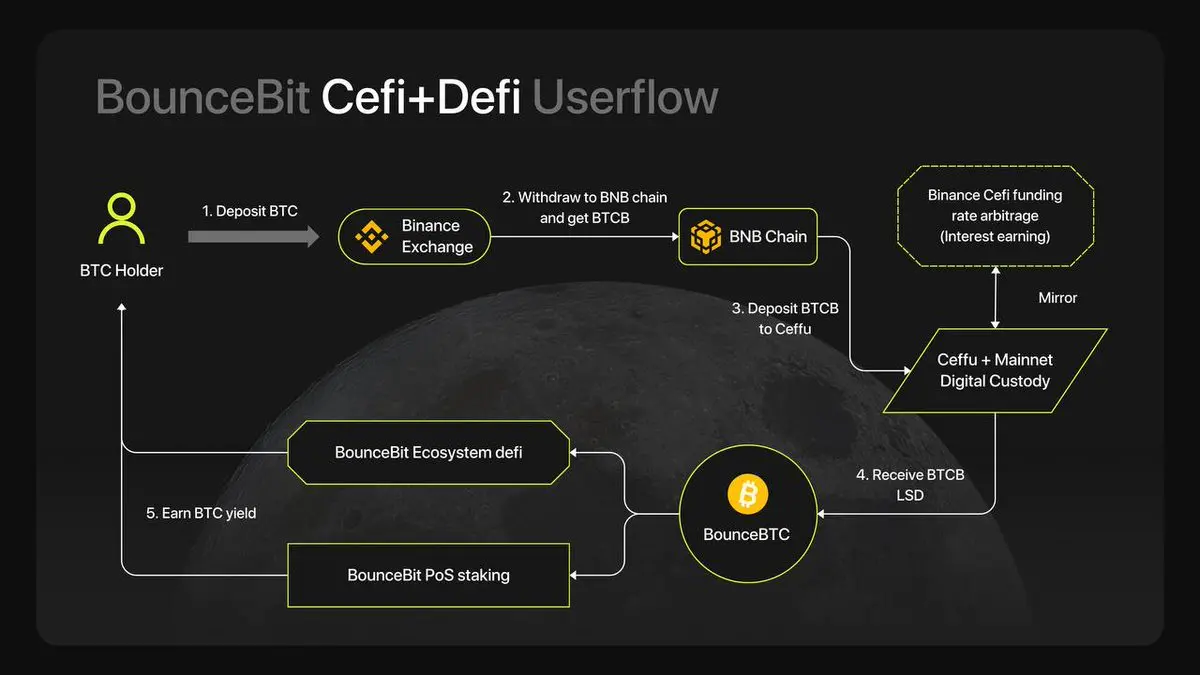An Analysis of BounceBit: How to Achieve a Closed Loop of BTC Native Asset Re-Staking Returns?
Written by: Haotian
Currently, the Ethereum Restaking track is in full swing, with Eigenlayer cleverly packaging "Ethereum security consensus" as a commodity for external output, forming a closed loop of POS chain restaking yields. How can the POW chain BTC achieve a restaking closed loop?
Yesterday, BounceBit completed a $6M financing round led by Blockchain Capital, attracting attention. How does it achieve BTC native asset Restaking? Next, I will share my understanding.
Originally, BTC assets, as mainstream assets with absolute consensus status, would cross-chain to Ethereum and other mainstream public chains in Wrapped form, appearing on the optional collateral lists of lending platforms like MakerDAO and AAVE. Typically, users stake BTC with trusted centralized custodians to generate WBTC ERC20 tokens, which are then utilized in Ethereum's DeFi ecosystem.
This can be considered a liquidity-sharing solution, but it has two issues:
1) The trusted centralized entities have excessive power, and the security of assets across chains relies on centralized platforms. This limits the weight of such Wrapped assets in the Ethereum system, as users naturally prefer Ethereum native assets like DAI and ETH, while being wary of external assets;
2) The native BTC asset, in its original POW environment, has no original yield. Cross-chaining it to other ecosystems is akin to plundering the ecological overflow yield of other chains, making it difficult to derive rich yield models. Low yields combined with high trust costs limit users' enthusiasm for cross-chain asset movement.
Based on this, we can infer that for a native BTC POW chain to derive a reliable and diversified yield closed-loop gain model, it needs to meet two conditions:
1) The POW chain must transform into a POS chain or have its own dedicated POS chain, where node Validators stake native assets to convert them into voting rights, thereby consolidating the security of the POS chain. This will provide the native asset with basic "mining" yields;
2) The staking LSD certificates should circulate within its extensive DeFi ecosystem to obtain various additional yields. If it can break the limitations of its own chain and spill liquidity into the entire chain or even off-chain environments to gain yields, that would be even better.
Understanding this level, it becomes easy to see BounceBit's restaking solution. In simple terms: BounceBit has built a layer1 POS chain parallel to BTC, focusing more on the subsequent circulation and yield issues of assets, unaffected by the current technical limitations of the BTC mainnet and the development bottlenecks of BTC layer2. Its goal is to bring rich and diverse yield models to BTC native assets, providing BTC holders with an optional wealth management possibility.
How it works?
1) BounceBit does not hide the "centralization" issue of cross-chain BTC native assets; it directly acknowledges it. However, it has chosen compliant CeFi platforms, allowing users to entrust their assets to custodial service platforms like Mainnet Digital and Ceffu, which have compliance qualifications.
After custody, users receive Wrapped assets like WBTC or BTCB on a 1:1 basis, and these compliant custodians have more robust designs in terms of asset transparency and financial auditing, providing trust guarantees for asset entry into the subsequent POS chain.
In theory, BTC holders could also directly use technologies like MPC cross-chain bridges to move assets to the BounceBit POS chain. This is currently a mainstream method for asset cross-chaining on layer two chains, but this type of cross-chain method is essentially also limited by the centralization of multi-signature entities, which is not much different from the centralization issue of compliant custodians.
2) Users can stake Wrapped assets and BounceBit tokens in the BounceBit chain's POS Validator verification system, effectively using a dual-token staking model to provide network security for the POS chain, obtaining stable annualized mining yields. Meanwhile, LSD certificates can earn additional mining yields in a series of DeFi protocols derived from the POS chain.
Staking annualized yields are relatively fixed, while the potential income from the subsequent development of the chain's ecosystem has significant imaginative space. For example, other DeFi protocols, oracles, and cross-chain bridges can restake the LSD to obtain new yields, meaning that the native token will benefit from the growth of the entire POS chain's subsequent ecosystem.
To quickly build the ecosystem, BounceBit supports programming-level connectivity with other EVM chains, making it easy to migrate applications over with low barriers. Of course, with this layer of chain abstraction, it also provides the technical possibility for LSD to spill over into other ecosystems to obtain yields.
3) Eigenlayer has innovatively proposed a very appealing narrative on the Ethereum chain, where active nodes (AVS) can participate in the network governance of other chains, exporting Ethereum's security consensus to other chains and thereby obtaining off-chain restaking yields. This is a core reason why this wave of Ethereum Restaking is crazy yet does not fear consensus overload.
Eigenlayer has seized the modularization trend, with more and more new chains attempting to quickly land demands on "security consensus," directly packaging the validator verification capabilities that overflow from Ethereum as a commodity of Ethereum security consensus for external output.
BounceBit has captured the solid holding demand of BTC asset holders, while BTC currently functions as a solitary chain, lacking effective liquidity penetration into other full-chain environments.
In response, BounceBit has created a fresh narrative of DeFi + CeFi, where users can earn incremental yields on the original CeFi custodial service platform by staking LSD certificates on custodial platforms. Behind this is actually anchored in the potential yield of a considerable off-chain financial market, which, in the context of the recent approval of BTC ETFs, is indeed a sexy and imaginative narrative.

Don't forget that compliant CeFi custodial platforms can also gain substantial off-chain benefits, such as staking mining, lending services, investment products, etc. Typically, to avoid systemic security risks, these assets will have transparent public disclosure mechanisms and necessary asset usage authorization thresholds.
In my view, this is the core innovation that BounceBit brings to the restaking of BTC native assets through its POS chain. BTC holders need a channel to obtain diverse yields, and BounceBit, centered on compliant CeFi platforms, has introduced a POS chain staking mining mechanism while extending LSD through Restaking into an infinitely imaginative CeFi original yield market.
A closed-loop restaking model that inputs predictable yield models for BTC assets has gradually formed.
From another perspective, isn't the BTC ETF itself a massive off-chain gain restaking solution? This approach, which combines the native yield environment on Web3 chains (POS staking) with off-chain incremental yields from Web2 (custodial yields), is particularly suitable for the current BTC ecosystem. It is not an exaggeration to call it the first innovative protocol in the BTC restaking track.
On a macro level, it can connect to potential growth opportunities of ETFs, while on a technical level, it can unlock subsequent explosive opportunities in the BTC restaking market. Economically, it can indeed bring triple yields to BTC holders, providing the possibility for POW chains like BTC to realize POS yield models.












